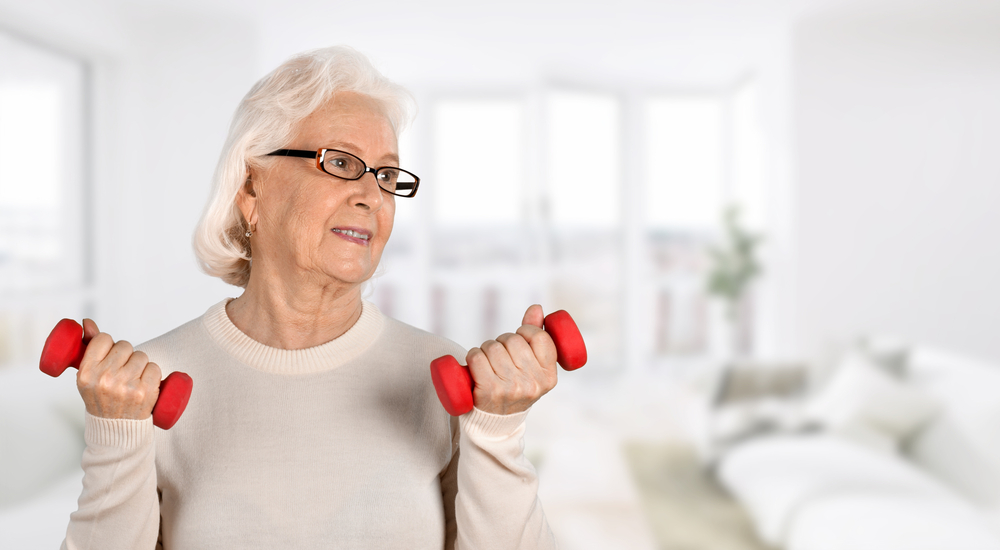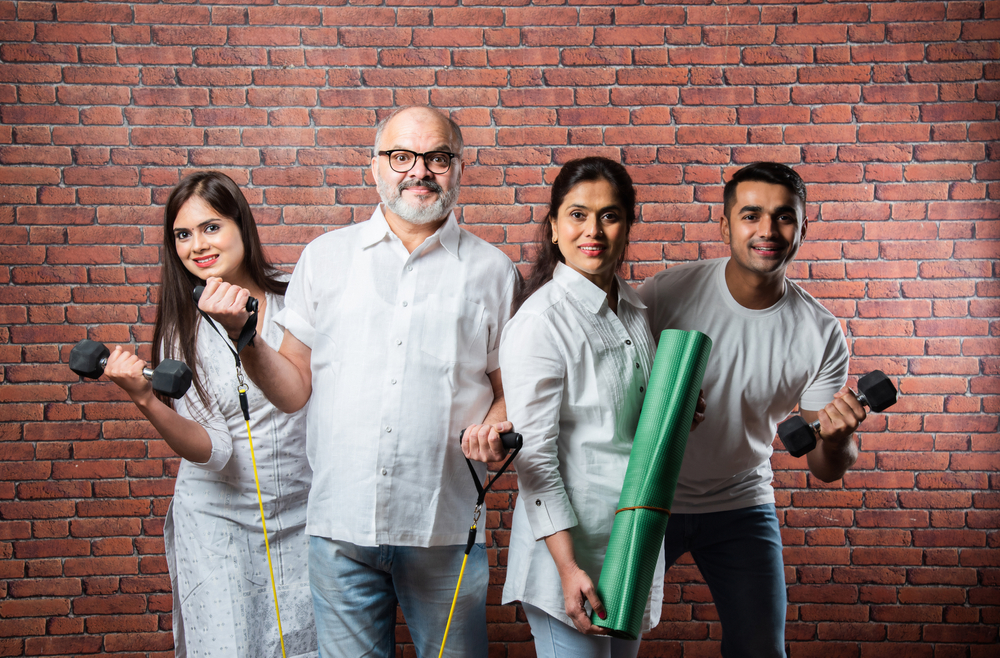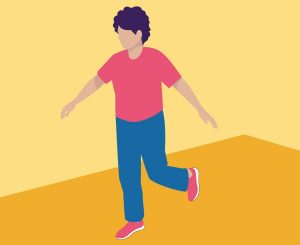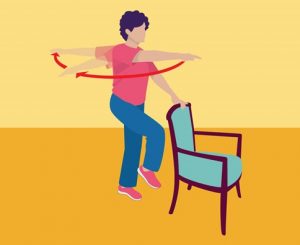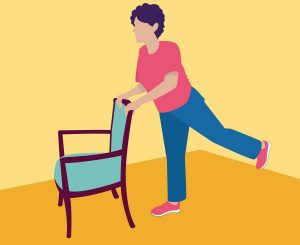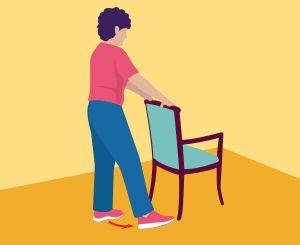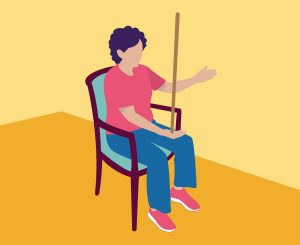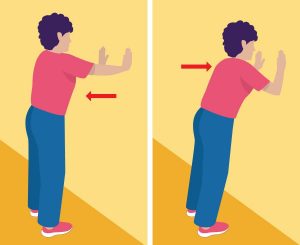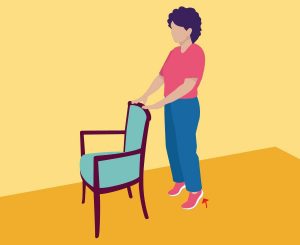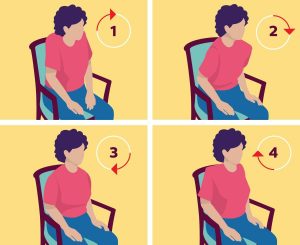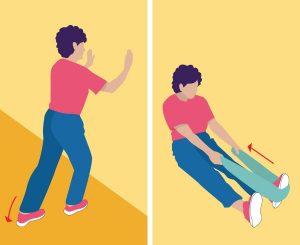Older adults should stay fit, body & mind, says Dr Binal Dave, as she suggests ways to exercise safely at home
Exercise is important in all phases of life, but for older adults, it’s important for them to maintain their independence, among other benefits.
When it comes to deciding the best exercises for seniors, variety is key. Adults of all ages—but especially people older than 65—should focus on a combination of strength, mobility, balance exercises and aerobic activities.
Across many countries, falls are one of the leading causes of injury for older adults. However, you should prevent yourselves from slips and falls. By exercising regularly, you can improve your balance and your strength, so that you can stand tall and feel more confident when walking.
No matter what your age or what type of physical ailments you are suffering from, it’s never too late to start exercising and get fit. These easy home exercise tips will help you get started safely and make it fun.
Why Exercise Matters for Older Adults
Exercise is important for older adults because being physically active makes it easier to perform activities of daily living (ADLs), including eating, bathing, toileting, dressing, getting into or out of a bed or chair and moving around the house or a neighbourhood. Physically active older adults are also less likely to fall, which can lead to serious injuries.
Exercise improves muscle strength and bone density as well, which is especially important for women since they lose bone density at a faster pace after menopause than men. Meanwhile, the benefits of exercise for the heart and lungs help promote overall health and offset some risks for chronic illnesses and disease.
A recent research study found that physical activity was the number one contributor to longevity, adding extra years to your life—even if you don’t start exercising until your senior years. But getting active is not just about adding years to your life, it’s about adding life to your years.
Getting moving can help boost your energy and is also good for your mind, mood, and memory. It’s never too late to find simple, enjoyable ways to become more active, improve your mood and outlook, and reap all of the physical and mental health benefits of exercise at home.
Physical health benefits of exercise for older adults
As an older adult, exercise at home can help you to:
Maintain or lose weight. As your metabolism naturally slows with age, maintaining a healthy weight can become a challenge. Regular exercise helps increase your metabolism and build muscle mass, helping your body to burn more calories.
Reduce the impact of illness and chronic disease. People who exercise tend to have improved immune and digestive functioning, better blood pressure and bone density, and a lower risk of Alzheimer’s disease, diabetes, obesity, heart disease, osteoporosis, and certain cancers.
Enhance your mobility, flexibility, and balance. Exercise improves your strength, flexibility, and posture, which in turn can help with your balance and coordination, and reduce your risk of falls.
Mental health benefits
Exercise can also help you to:
Improve how well you sleep. Quality sleep is vital for your overall health as you get older. Regular activity can help you fall asleep faster, sleep more deeply, and wake feeling more energetic and refreshed. Boost your mood and self-confidence. Exercise is a huge stress reliever and the endorphins produced can actually help reduce feelings of sadness, depression, and anxiety. Being active and feeling strong can also help you feel more self-confident.
Improve your brain function Activities like Sudoku or crossword puzzles can help keep your brain active, but little comes close to the beneficial effects of exercise on the brain. It can aid brain functions as diverse as multitasking and creativity, and help to prevent memory loss, cognitive decline, and dementia. Getting active may even help slow the progression of brain disorders such as Alzheimer’s disease.
Building a balanced exercise plan
Staying active is not a science. Just remember that mixing different types of physical activity helps to both keep your workouts interesting and improve your overall health. The key is to find activities at home that you enjoy—based on the four building blocks of fitness. These are:
1: Balance
What it is: Balance exercises help maintain standing and stability, whether you’re stationary or moving around. Try yoga, tai chi, and posture exercises to gain confidence with balance.
Why it’s good for you: It improves your balance, posture, and the quality of your walking. It also reduces your risk of falling or fear of falls.
2: Cardio
What it is: Cardiovascular exercise uses large muscle groups in rhythmic motions over a period of time. It gets your heart pumping and may even leave you feeling a little short of breath. Cardio workouts include walking, stair climbing, swimming, hiking, cycling, rowing, tennis, and dancing.
Why it’s good for you: Cardio exercise helps lessen fatigue and shortness of breath. It also promotes independence by improving endurance for daily activities such as walking, house cleaning, and errands.
3: Strength and power training
What it is: Strength training builds up muscle with repetitive motion using weight or external resistance from machines, free weights, elastic bands, or your own body weight. Power training is often strength training done at a faster speed to increase power and reaction times.
Why it’s good for you: Strength training helps prevent loss of bone mass, builds muscle, and improves balance—important for staying active and avoiding falls. Power training can improve your speed while crossing the street, for example, or prevent falls by enabling you to react quickly if you start to trip or lose balance. Building strength and power will help you stay independent and make day-to-day activities such as opening a jar, getting in and out of a car, and lifting objects easier.
4: Flexibility
What it is: Flexibility workouts challenge the ability of your body’s joints to move freely through a full range of motion. This can be done through stationary stretches or stretches that involve movement to keep your muscles and joints supple and less prone to injury. Yoga is an excellent means of improving flexibility.
Why it’s good for you: Flexibility helps your body stay limber and increases your range of movement for ordinary physical activities, such as looking behind while driving, tying your shoes, shampooing your hair, or playing with your grandchildren.
Getting started safely at home
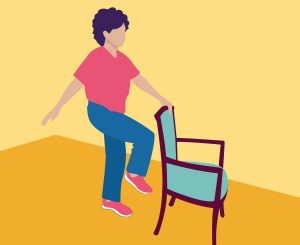 Exercise 1: Single Limb Stance
Exercise 1: Single Limb Stance
It’s best to start off with a simple balance exercise for seniors. Here’s how you do this one: stand behind a steady, solid chair (not one with wheels), and hold on to the back of it. Lift up your right foot and balance on your left foot. Hold that position for as long as you can, then switch feet.
The goal should be to stand on one foot without holding onto the chair and hold that pose for up to a minute.
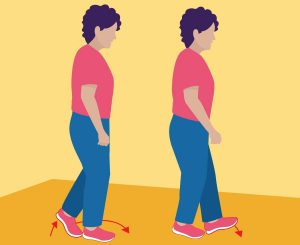 Exercise 2: Walking Heel to Toe
Exercise 2: Walking Heel to Toe
You might read this and wonder, “How is walking an exercise to improve balance?” This exercise makes your legs stronger, which enables you to walk without falling.
Put your right foot in front of your left foot so that the heel of your right foot touches the top of the toes of your left foot. Move your left foot in front of your right, putting your weight on your heel. Then, shift your weight to your toes. Repeat the step with your left foot. Walk this way for 20 steps.
Stand with your feet apart, so that the space between them is the same width as your hips. Make sure both feet are pressed into the ground firmly. Stand straight, with your head level. Then, transfer your weight to your right foot and slowly lift your left leg off the ground. Hold that position for as long as possible (but no more than 30 seconds).
Slowly put your foot back onto the ground, then transfer your weight to that foot. Slowly lift your opposite leg. Start by doing this exercise for balance five times per side, then work your way up to more repetitions.
You’ll need a chair for this exercise.
Imagine that you are standing in the centre of a clock. The number 12 is directly in front of you and the number 6 is directly behind you. Hold the chair with your left hand.
Lift your right leg and extend your right arm so it’s pointing to the number 12. Next, point your arm towards the number three, and finally, point it behind you at the number 6. Bring your arm back to the number three, and then to the number 12. Look straight ahead the whole time.
Repeat this exercise twice per side.
This strength training exercise for seniors makes your bottom and your lower back stronger.
Stand behind a chair. Slowly lift your right leg straight back – don’t bend your knees or point your toes. Hold that position for one second, then gently bring your leg back down. Repeat this ten to 15 times per leg.
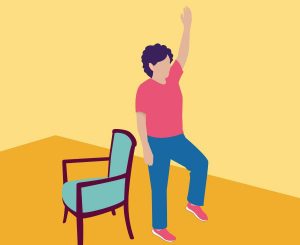 Exercise 6: Single Limb Stance with Arm
Exercise 6: Single Limb Stance with Arm
This balance exercise for seniors improves your physical coordination.
Stand with your feet together and arms at your side next to a chair. Lift your left hand over your head. Then, slowly raise your left foot off the floor. Hold that position for ten seconds. Repeat the same action on the right side.
You’ll need a chair for this exercise to improve balance.
Stand behind the chair with your feet slightly apart. Slowly lift your right leg to the side. Keep your back straight, your toe facing forward, and stare straight ahead. Lower your right leg slowly. Repeat this exercise ten to 15 times per leg.
This balance exercise for seniors can be performed while seated. You’ll need a cane or some kind of stick. A broomstick works well for this – just remove the broom’s head before you start.
Hold the bottom of the stick so that it’s flat on the palm of your hand. The goal of this exercise is to keep the stick upright for as long as possible. Change hands so that you work on your balance skills on both sides of your body.
As long as you’ve got a wall, you can do this strength training exercise for seniors.
Stand an arm’s length in front of a wall that doesn’t have any paintings, decorations, windows or doors. Lean forward slightly and put your palms flat on the wall at the height and width of your shoulders. Keep your feet planted as you slowly bring your body towards the wall. Gently push yourself back so that your arms are straight. Do twenty of these.
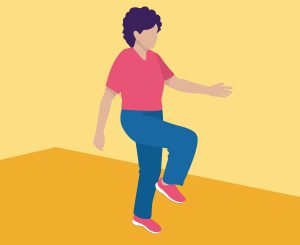 Exercise 10: Marching in Place
Exercise 10: Marching in Place
Marching is a great balance exercise for seniors. If you need to hold onto something, do this exercise in front of a counter.
Standing straight, lift your right knee as high as you can. Lower it, then lift the left leg. Lift and lower your legs 20 times.
This strength training exercise for seniors also improves balance. You’ll need a chair or a counter.
Stand straight and put your arms in front of you. Raise yourself up on your toes as high as you can go, then gently lower yourself. Don’t lean too far forward on the chair or counter. Lift and lower yourself 20 times.
This is a simple exercise for seniors. You can do it seated or standing.
Rotate your shoulders gently up to the ceiling, then back and down. Next, do the same thing, but roll them forwards and then down.
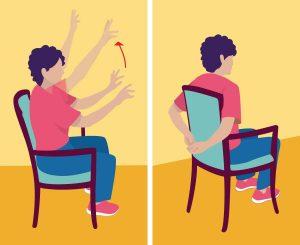 Exercise 13: Hand and Finger Exercises
Exercise 13: Hand and Finger Exercises
The following are exercises to improve flexibility. You don’t need to stand for these.
In the first exercise, pretend there’s a wall in front of you. Your fingers will climb the wall until they’re above your head. While holding your arms above your head, wiggle your fingers for ten seconds. Then, walk them back down.
During the second exercise, touch your hands while they’re behind your back. Reach for your left hand while your right hand is behind your back. Hold that position for ten seconds, then try with your other arm.
These strength training exercises for seniors can be performed sitting or standing.
To do calf stretches while standing, find a wall with nothing on it. Stand facing the wall with your hands at eye level. Place your left leg behind your right leg. Keep your left heel on the floor and bend your right knee. Hold the stretch for 15 to 30 seconds. Repeat two to four times per leg.
If you want to stretch your calves while sitting, you’ll need a towel. Sit on the floor with your legs straight. Put the towel around the soles of your right foot and hold both ends. Pull the towel towards you while keeping your knee straight and hold it for 15 to 30 seconds. Repeat the exercise two to four times per leg.
Images credit: Lifeline.ca




